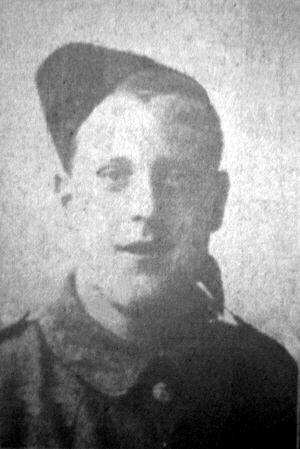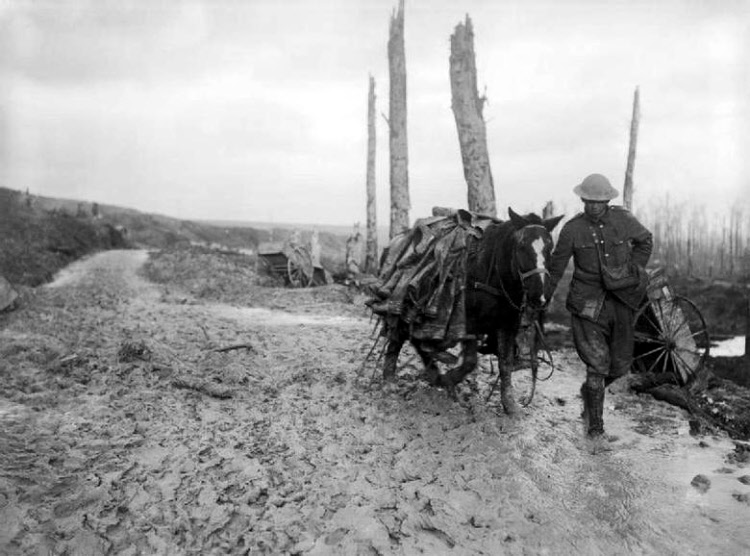
Walter Terry was born in Ossett in the summer of 1893, the son of Darrington-born John Terry and his wife, Ossett-born Ada (nee Smith) who were married in late 1892. Walter was their only child, the couple having lost another child before 1911. In 1901 and also in 1911, the Terry family were living at Ellis’s Yard, The Green, Ossett and John Terry worked as a railway plate layer. In 1911, Walter Terry was working as a colliery coal screener.
The 2nd Battalion of the Highland Light Infantry was formed in August 1914 at Aldershot as part of 5th Brigade in 2nd Division. They landed in Boulogne on the 14th August 1914 at the start of WW1.
Private Terry died during the fighting at the Battle of the Ancre, between the 13th to the 16th November 1916 with the 2nd Battalion, Highland Light Infantry as a part of 2nd Division. The Battle of Ancre was the final phase of the first battle of the Somme, involving an attack on the German front line and the crossing of the Ancre River, a front that had been attacked on the first day of the battle but without any success. The objective of the battle was as much political as it was military with British commander-in-chief, General Sir Douglas Haig saying the success would hearten the Russian and Romanian fronts as well as proving good for morale in Britain.
On the 15th November 1916, in II Corps, the 39th Division completed the capture of Schwaben Redoubt, which took until 11:00 p.m. In V Corps, the 37th Division relieved the 63rd Division and linked with the 51st Division to the north. Bombing attacks began up Beaucourt Trench towards Munich Trench, which reached the 51st Division around 10:00 a.m. Patrols to Muck and Railway trenches found them empty (except for mud). Companies of the 51st and 2nd divisions attacked at 9:00 a.m. and were caught in the German artillery barrage, some troops reaching Frankfort Trench then returning to New Munich Trench. A 2nd Division attack with two battalions of the 37th Division lost direction in the mist and fell back to Wagon Road with many casualties, while a third battalion strengthened the left flank by bombing forward and building a strong point in the Quadrilateral, near the top of Redan Ridge, as two tanks in support bogged down early.
The “Ossett Observer”, 1 had this obituary for Walter Terry:
“Missing Ossett Man Now Reported Killed – Private Walter Terry (24), of the Highland Light Infantry, whose widowed mother resides at 4, Ellis’s-yard, The Green, Ossett, has been missing from the regiment since about the middle of November last year, and news has recently been received that he was killed in action on the date he was missed. Deceased was formerly employed at Messrs. J. and T. Brook’s mill, Flushdyke and was a popular member of the Horbury and District Clarion Cycling Club. He joined the forces early last year.“

Above: A pack horse in the mud at Beaumont Hamel during the Battle of the Ancre in November 1916.
Walter Terry’s army record has not survived and his medal card indicates that he was awarded the British and Victory medals, but did not serve overseas before the 31st December 1915. The army recorded his service number as 29534 on his medal card, but the Commonwealth War Graves Commission web site has it as 29524.
Private Walter Terry died on the 15th November 1916, aged 24 years and he is remembered on Pier and Face 15C at the Thiepval Memorial, 2 Somme, France. The Thiepval Memorial will be found on the D73, next to the village of Thiepval, off the main Bapaume to Albert road (D929).
On 1 July 1916, supported by a French attack to the south, thirteen divisions of Commonwealth forces launched an offensive on a line from north of Gommecourt to Maricourt. Despite a preliminary bombardment lasting seven days, the German defences were barely touched and the attack met unexpectedly fierce resistance. Losses were catastrophic and with only minimal advances on the southern flank, the initial attack was a failure. In the following weeks, huge resources of manpower and equipment were deployed in an attempt to exploit the modest successes of the first day. However, the German Army resisted tenaciously and repeated attacks and counter attacks meant a major battle for every village, copse and farmhouse gained. At the end of September, Thiepval was finally captured. The village had been an original objective of 1 July. Attacks north and east continued throughout October and into November in increasingly difficult weather conditions. The Battle of the Somme finally ended on 18 November with the onset of winter.
In the spring of 1917, the German forces fell back to their newly prepared defences, the Hindenburg Line, and there were no further significant engagements in the Somme sector until the Germans mounted their major offensive in March 1918.
The Thiepval Memorial, the Memorial to the Missing of the Somme, bears the names of more than 72,000 officers and men of the United Kingdom and South African forces who died in the Somme sector before 20 March 1918 and have no known grave. Over 90% of those commemorated died between July and November 1916. The memorial also serves as an Anglo-French Battle Memorial in recognition of the joint nature of the 1916 offensive and a small cemetery containing equal numbers of Commonwealth and French graves lies at the foot of the memorial.
References:
1. “Ossett Observer”, May 5th 1917